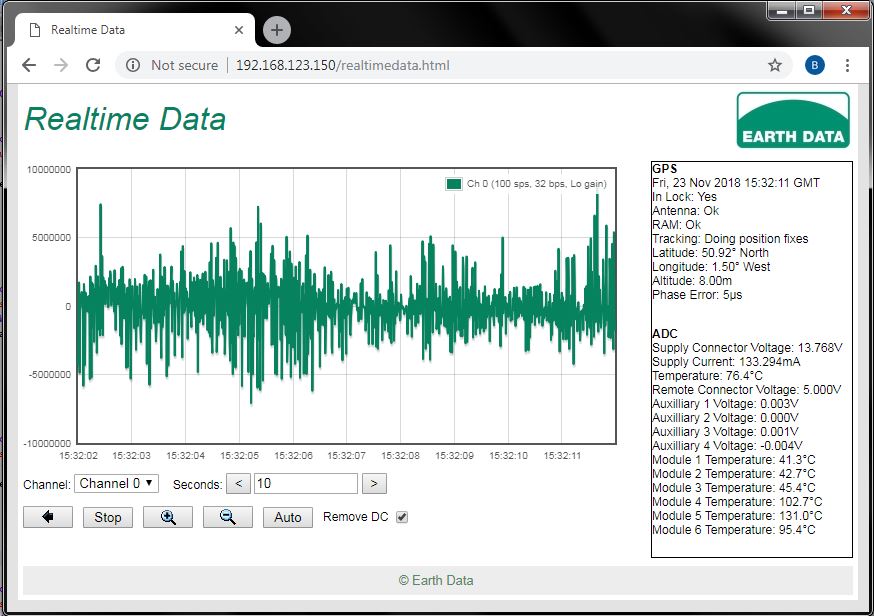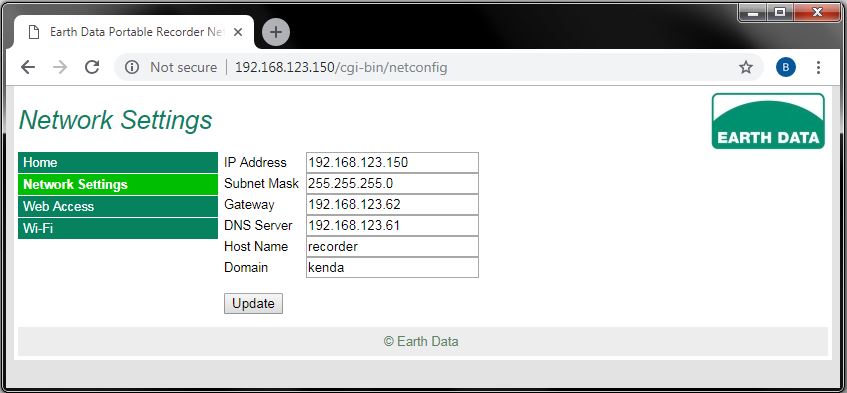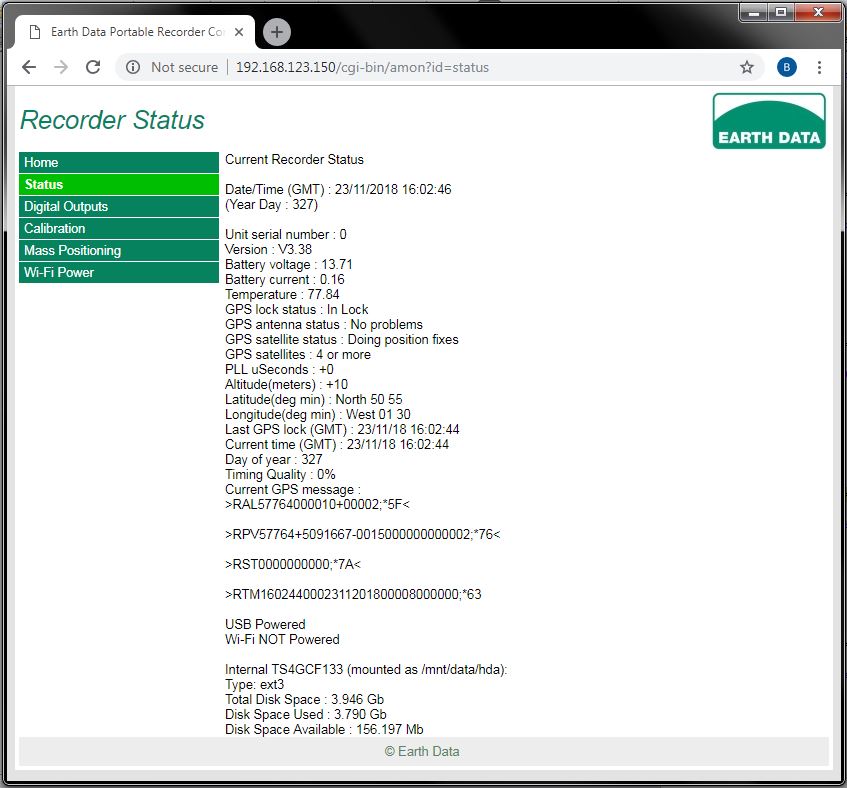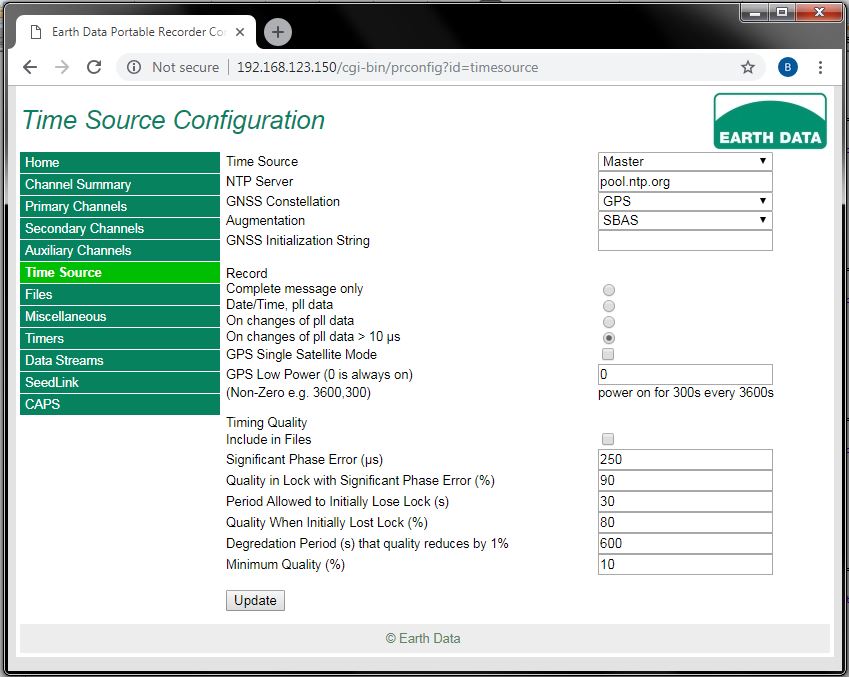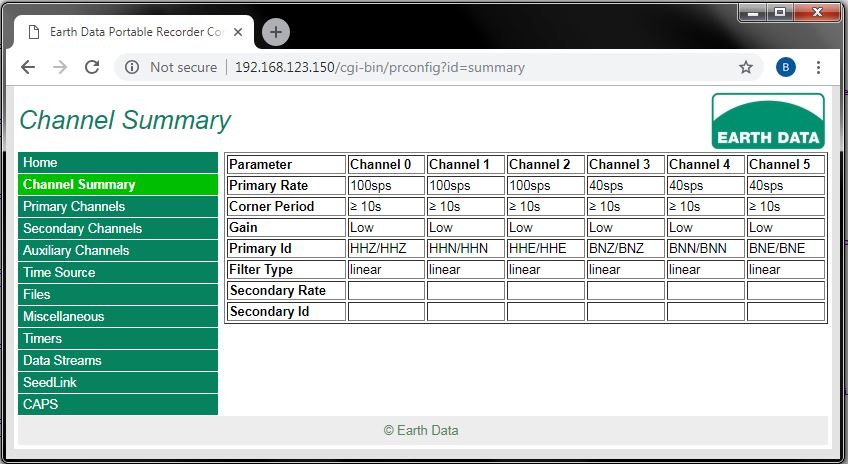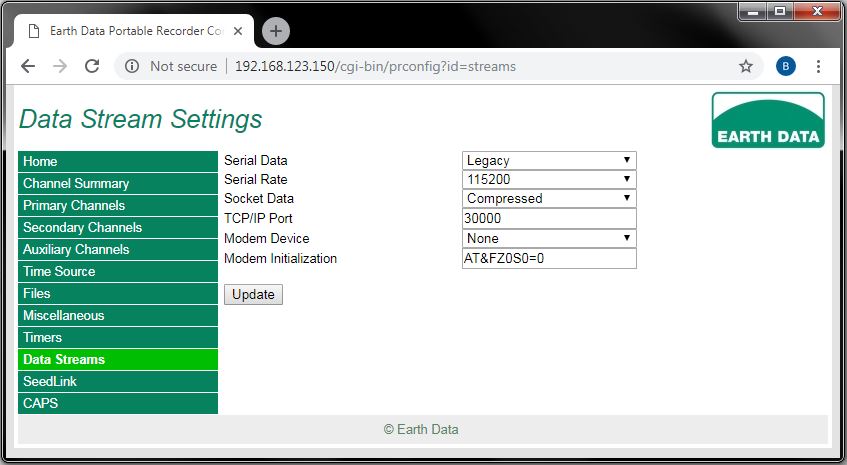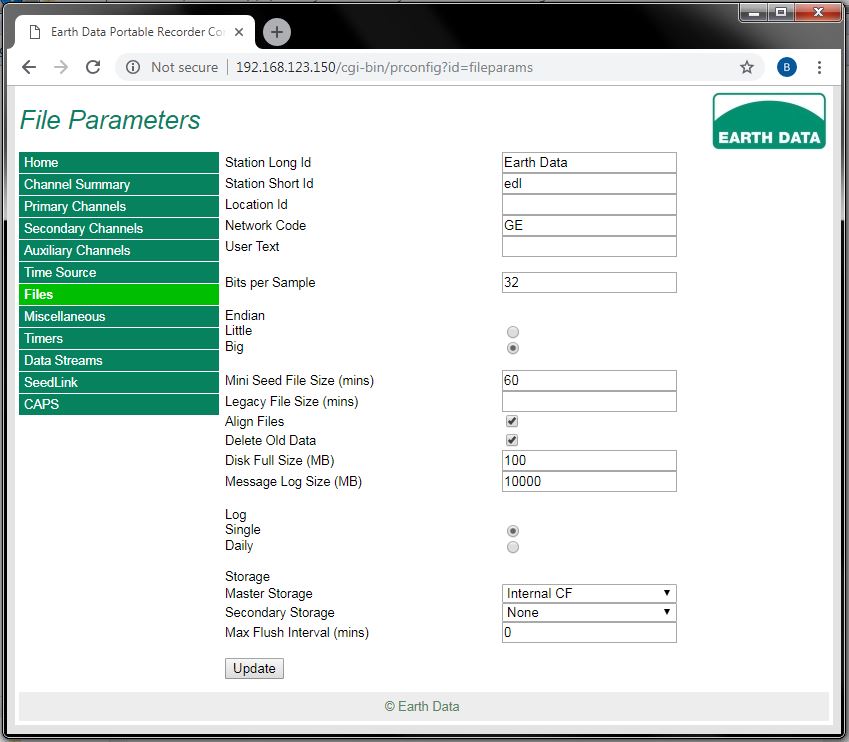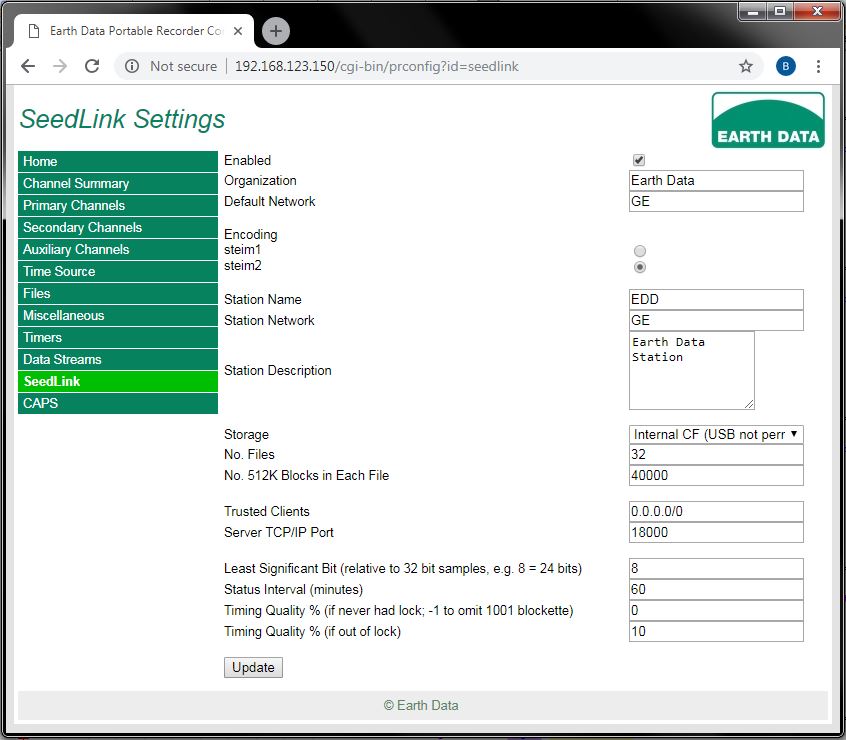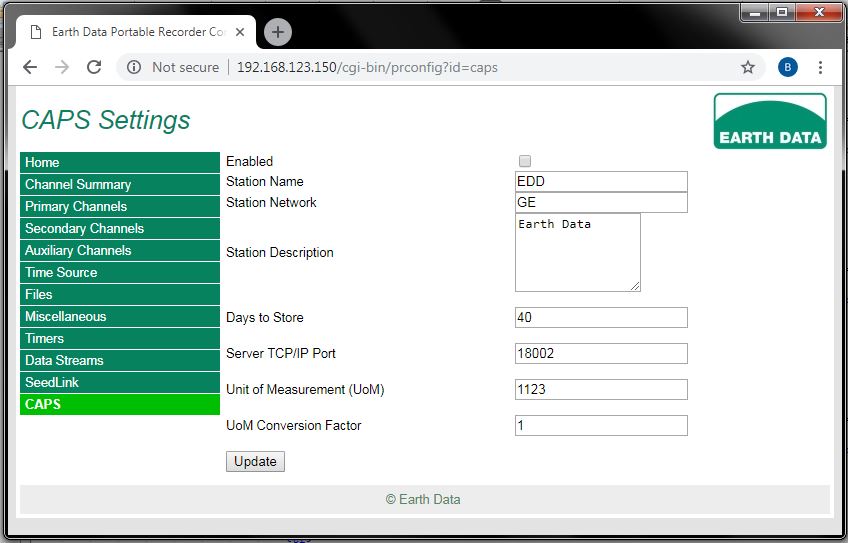Product description
The EDR-217 is the latest in the range of ruggedized digitizers and is nearly half the size of the EDR-209. Its robust, compact footprint, versatile connectivity options and ultra-low power consumption make it ideal for use on remote projects where access is difficult. It provides up to eight independent channels of extremely high resolution with sample rates from 1 to 3,000 samples/sec. Channels can be switched off to reduce power so that any number from one to eight can be active. A selectable output word size of up to 32-bits is available.
SIGNAL TO NOISE
A signal to noise ratio of typically 145 dB is achieved at a sample rate of 100 Hz falling to 125 dB at 1,000 Hz using a 24-bit word. 150 dB is obtained below 10 Hz when a 32-bit word size is selected.
The signal bandwidth is always d.c. to 0.4 of the selected sample rate (± 0.1 dB) with over 140 dB of rejection above the half sampling frequency, negating any requirement for anti-alias filtering.
SIGNAL INPUTS
Up to eight channels of fully differential high resolution inputs are available. Common mode rejection is better than 100dB. One of four sensitivity settings can be selected. Up to ± 20 volts can be accommodated on the least sensitive setting. In addition to the standard for auxiliary input low resolution channels that can be recorded at low sample rate for monitoring external parameters.
CONVERTERS
The converters use a 7th order Delta Sigma technique developed by Earth Data. In addition to their high dynamic range they are also free from spurious tones and artefacts present in alternative designs.
TIMING
The unit includes an internal GNSS receiver, capable of being configured to receive and track multiple GNSS constellations: GPS, GLONASS, Galileo, and BeiDou. In addition, the receiver can be configured to support various augmentation systems: SBAS (WAAS, EGNOS, MSAS and GAGAN), QZSS and IMES. Where conditions dictate, the unit away and power cycling modes can be used in both modes in order to conserve power. Alternative time sources such as NTP servers can be used.
STATUS
Power supply voltage, current, internal temperature, and GNSS status are continuously monitored and reported.
CONNECTION & INTERFACES
The EDR-217 can be configured and monitored via any standard HTTP web browser, in addition, it can also be configured as a SeedLink server enabling communication with external seismic systems. The internal mass storage media can be employed to store data in Mini-SEED format, or alternatively external mass storage units can be directly connected via USB. The unit supports the FTP and RSYNC protocols should remote users wish to download / synchronize any stored data files.
ENVIRONMENTAL
The EDR-217 is available in a fully sealed extruded aluminium case or as a board only OEM product. Standard operating temperature range is -20 °C to +60 °C, or an extended range of -40 °C to +60 °C.
GENERAL
No. of channels
4 or 8 differential input
Input impedance
1 MΩ (any input to ground)
Input CMRR
Better than -100 dB
Number of gain ranges
4 (very low gain; low gain; high gain; very high gain)
Input sensitivity
20 nV, 100 nV or 2.5 µV per bit (24-bit word size)
Input range
±0.16 V, ±0.8 V, ±20 V user programmable
Gain accuracy
Within 0.1 dB after auto-calibration
D.C. offset
±5 µV low gain and very low gain; ±1 µV high gain.
Crosstalk
Better than -120 dB
A TO D CONVERTERS
Number of A to D converters
4 or 8 (one per channel)
Type
Earth Data proprietary Delta Sigma Converter
Sampling frequency
192 KHz
Filter type
Linear phase
Minimal phase
Alias protection
Spurious in band signals better than -120 dB as a result of any frequency above the passband and any amplitude up to full scale.
Primary sample rates
1, 2, 4, 5, 10, 20, 25, 40, 50, 75, 100, 120, 125, 150, 200, 250, 300, 375, 500, 600, 750, 1000, 2000, 3000
Secondary sample rates
As above (4 channel unit); Sub-division of primary rate (8 channel unit)
RMS to RMS noise
150 dB below 10 Hz
140 dB below 100 Hz
125 dB below 1000 Hz
Analogue response
d.c. to 0.4 of selected sample rate
Spurious tones
Nothing above -160 dB (input short circuit)
Intermodulation products
Less than -120 dB for any two sine wave frequencies within the passband at half full scale amplitude
Timing accuracy
Better than ±10 µs (GPS locked)
Sensor power
12 V ±0.2 V available on input connector. (100 µA current limited)
AUXILLARY INPUT CHANNELS
Number of channels
4 plus 3 on each input connector (total of 7 on a four channel unit; 10 on an eight channel unit)
Type of conversion
Multiplexed successive approximation; 16 bit
OUTPUT
Available interfaces
Ethernet; RS232; RS485; USB
Internal storage
Onboard FLASH, Buffer size and Data Logger capabilities enabled by fitting internal Micro SD card (typically 32 GB, larger capacities are available if required). Data files typically stores as Mini-SEED.
TCP/IP
HTTP/HTTPS, FTP/FTPS, SFTP, RSYNC
Application protocols
SEEDLink, CAPS, MODMAN.
Real time data latency
<0.5s
ADDITIONAL FEATURES
Sensor control
4 auxilary outputs (mass lock, mass unlock, mass centre with automatic monitoring support, calibration enable) configuration as TTL or Open Collector (to 50V)
Sensor calibration
Sine Wine, Square Wave (Pulse), White Noise (all configuration)
GNSS
Internal with external option available
GNSS constellations
GPS, GLONASS, Galileo and BeiDou (configurable as standalone or concurrent combinations)
GNSS augmentation systems
SBAS (WAAS, EGNOS, MSAS and GAGAN), QZSS and IMES (configurable)
ENVIRONMENTAL
Housing
Extruded alluminium
Water proofing
Extruded alluminium
Operating temperature
-20 to +60 °C
Storage temperature
-40 to +80 °C
POWER REQUIREMENTS
Supply voltage range
10.5 V to 28 V
Power consumption
500 mW (no comms 4 channel unit); 1.2 W (ethernet, 4 channel unit); 1.5 W (ethernet and USB. 4 channel unit)
SIZE AND WEIGHT
Dimensions
Length: 103 mm; Width: 108 mm; Depth: 45 mm;
Interfaces
Serial
(Diagnostic Debug port, Modmon protocol port, GPRS/PSTN Modem)
Ethernet
(Secure Sockets Layer and Shell: SSL/SSH, supports HTTP/HTTPS, FTP/FTPS, SFTP, RSYNC, SEEDLink, CAPS)
Optional WLAN
(can be bridged with ethernet IP address)
USB
(support for externally connected mass storage media)
Storage
Internal Micro SD
Support for externally connected mass storage media via USB
Supported Media: FLASH Media, Micro SD, HDD, SSD *
Media determined by experiment conditions & capacity requirements
Data stored in Mini-SEED format
Configurable file lengths
* HDD - Hard Disk Drive; SSD - Solid State Disk
Utilities & Updates
This content is only for Registered users!
The SeedLink protocol is a robust data transmission intended for use on the Internet or private circuits that support TCP/IP.
The protocol is robust in that clients may disconnect and reconnect without losing data, the transmission is started where it ended.
Requested data streams may be limited to specific stations, locations and/or channels. All data packets are 512-byte Mini-SEED records.
Available Software
The following software is available from the DMC at
http://www.iris.edu/pub/programs/SeedLink/ :
libslink - A SeedLink client library written in C.
slink2orb - SeedLink to Antelope ORB client (licensed Antelope libraries are required).
slink2ew - SeedLink to Earthworm client. Windows binaries available.
slarchive - A SeedLink client that writes all received data to the local disk in user defined directory and file structures.
slinktool - Command line SeedLink client useful for data stream inspection and server testing.
ewexport_plugin - An Earthworm export process plugin (data source) for a seedlink server.
orbplugin - An Antelope ORB plugin (data source) for a seedlink server (licensed Antelope libraries are required).
SeedLink was originally created as the transport layer for the SeisComP package developed by GEOFON.
The Common Acquisition Protocol Server (CAPS) was developed to fulfill the needs to transfer multi-sensor data from the station to the data center. As nowadays more and more stations with co-located sensors like broadband seismometer, accelerometer, CGPS, temperature, video cameras, etc. are built up, a acquisition protocol is required, which can efficiently handle low and high-sampled data through one unified protocol.
Application
real-time data transmission from remote sensor to data center
center to center data transfer
Features
multi-sensor data transfer, e.g. waveform data, webcam images
redundant data transmission
ensures timeliness of data
on the fly reconfiguration
lightweight protocol for minimized packet overhead
archived and real-time data served through one protocol and one connection
reliable data transfer, retransmission of data in case of network outage or server restart
Web interface for server monitoring and data review
secure communication via SSL
fine-grained access control
connectivity to the SeisComP3 framework


